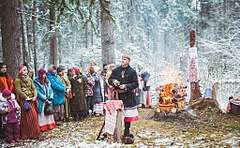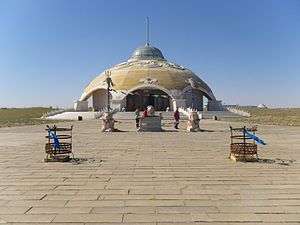List of Neopagan movements

Neopaganism (also modern paganism or contemporary paganism) encompasses a wide range of religious groups and individuals. These may include old occult groups, those that follow a New Age approach, those that try to reconstruct old ethnic religions, and followers of the pagan religion of Wicca. For organizations, the founding year is given in brackets.
Early movements
.png)
Pre-World War II neopagan or proto-neopagan groups, growing out of occultism and/or Romanticism (Mediterranean revival, Viking revival, Celtic revival, etc.).
- Neo-druidism
- Ancient Order of Druids (1781)
- The Druid Order (1909)
- Hermetic Order of the Golden Dawn (1888)
- Crowleyan Thelema (1904)
- Germanic neopaganism/Armanism
- Germanische Glaubens-Gemeinschaft (1907)
- Guido von List Society (1908)
- Church of the Universal Bond (1912)
- Adonism (1925)
Witchcraft
Wicca originated in 1940s Britain and became the mainstream of Neopaganism in the United States in the 1970s. There are two core traditions of Wicca which originated in Britain, Gardnerian and Alexandrian, which are sometimes referred to as British Traditional Wicca. From these two arose several other variant traditions. Wicca has also inspired a great number of other witchcraft traditions in Britain, Europe and the United States, most of which base their beliefs and practices on Wicca. Many movements are influenced by the Movement of the Goddess, and New Age and feminist worldviews.
Wicca
.png)
- British Traditional Wicca
- Gardnerian Wicca (1954)
- Alexandrian Wicca (1967)
- Central Valley Wicca (1969)
- Algard Wicca (1972)
- Chthonioi Alexandrian Wicca (1974)
- Blue Star Wicca (1975)
- Eclectic Wicca and Inclusive Wicca
- Celtic Wicca
- Saxon Wicca
- Dianic Wicca
- McFarland Dianic Wicca
- Faery Wicca
- Georgian Wicca
- Odyssean Wicca
- Wiccan church
- New Reformed Orthodox Order of the Golden Dawn (1968)
- Church and School of Wicca (1968)
- Circle Sanctuary (1974)
- Covenant of the Goddess (1975)
- Aquarian Tabernacle Church (1979)
- Rowan Tree Church (1979)
- Covenant of Unitarian Universalist Pagans (1985)
- Coven of the Far Flung Net (1998)
Other
- Stregheria (Italian tradition)
- Hedge Witchcraft
- Cochrane's Craft
- Feri Tradition
- Children of Artemis
New Age, eclectic or syncretic
Ethnic
Germanic
Heathenism (also Heathenry, or Greater Heathenry), is a blanket term for the whole Germanic Neopagan movement. Various currents and denominations have arisen over the years within it.
- English-speaking world/North America
- American Asatru
- Asatru Free Assembly (Stephen McNallen, 1974–1986)
- Ring of Troth (1987)
- Asatru Folk Assembly (1996)
- Odinism
- Odinist Fellowship (United States) (Else Christensen, 1971–2005)
- Odinic Rite (1973)
- Odinist Fellowship (United Kingdom) (1988)
- International Asatru-Odinic Alliance (1997–2002)
- Theodism (American tribalist movements)
- American Asatru
- Scandinavia
- Íslenska Ásatrúarfélagið (1972)
- Foreningen Forn Sed (1999)
- Samfälligheten för Nordisk Sed (1999)
- Swedish Asatru Assembly (1994)
- Åsatrufellesskapet Bifrost (1996)
- German-speaking Europe
- Eldaring (2000)
- Latin-speaking Europe
- Russian-speaking world/Russia
- Dark Ashtree community
- Скидбладнир
- Germanic mysticism (Armanism or Irminism/Irminenschaft/Ariosophy and Nordic racial paganism
- Heidnische Gemeinschaft (1985)
- Artgemeinschaft (1951)
- Deutsche Heidnische Front (1998)
- New Armanen-Orden
- Odin Brotherhood
- Wotanism
Celtic
- Celtic Reconstructionist Paganism (1980s)
- Neo-druidism or Neodruidry, or druidism or druidry
- Reformed Druids of North America (1963)
- Order of Bards, Ovates and Druids (1964)
- Monastic Order of Avallon (1970)
- Ár nDraíocht Féin (1983)
Italic
- Italo-Roman neopaganism or Religio Romana
Slavic

- Rodnovery (Native Faith) (1934 or 1921)
- Native Ukrainian National Faith, RUNVira (1964)
- Union of the Veneds (1986)
- Native Polish Church (1995)
- Rodzima Wiara (1996)
- Union of Slavic Native Belief Communities (1997)
- Native Faith Association of Ukraine (1998)
- Rodnover Confederation (2015)
Other European
.png)
Turkic-Mongolic
